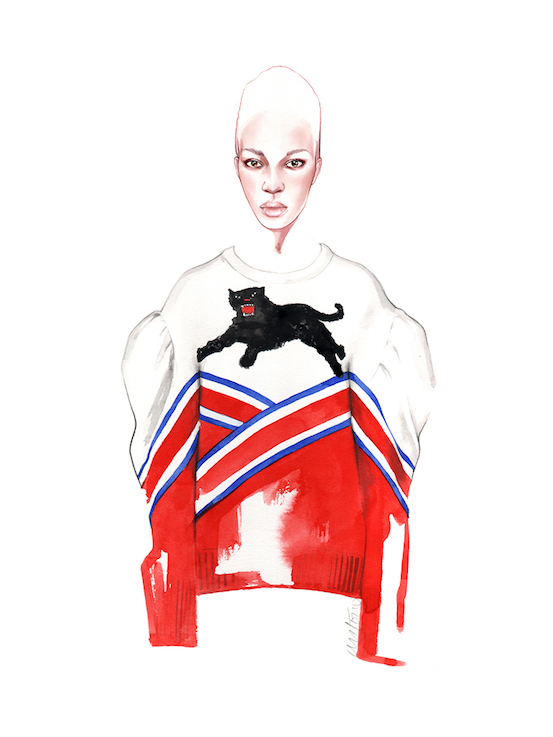THE ENORMOUS ADVANTAGES OF FORM
The pictures in comic strips today have become less ambitious and imaginative.
The strips which first established the greatness of the medium had a strong visual character. Today the drawings have become simpler and more basic, even as the words have become more adult and sophisticated.
You'll find no images in comic strips today like the grand images from Hal Foster's Prince Valiant:
You'll find no powerful chiaroscuro drawings such as these from Milton Caniff's Terry and the Pirates:
You see no displays of visual imagination such as this from Gasoline Alley:
or this from Lyonel Feininger's Wee Willie Winkie:
Feininger imagines the black smoke from the locomotive smokestack as "giants" while the steam from the cylinders becomes white rabbits running alongside the train:

George Herriman's visual layouts were crucial to his poetic content:
The words in Alex Raymond's Flash Gordon were pretty silly, but Raymond's drawings were quite eloquent. Note his strong brush work describing Dr. Zarkov's back:
Such worlds are gone from comic strips, having migrated to movie screens.
Why have so many strips today settled for a low grade functionality?
People have offered many explanations: smaller size, changed economics, different priorities. I'd like to suggest another explanation: drawings have become dumber because comic strip audiences are less appreciative of the importance of form. The modern appetite for comic strips has shifted from form to content; rudimentary drawings in simplistic, repetitive compositions don't slow the intake of a joke.
Whatever the reason, there's an awful lot of mediocre drawing in popular strips today.
In this example, the woman's rolls of fat make no sense, and the folds on her shirt work against the humor of the drawing. Those spasmodic motion lines surrounding both the woman and Opus suggest movement in all directions simultaneously. Opus is running on a floor substantially higher than the one on which the woman stands. I don't mind the ugly colors since the artist is going for a grotesque effect, but here the light source and purple shading are as aimless as the line work.
There's no law that pictures must be internally consistent-- George Herriman made an art of inconsistency-- but the sloppiness of so much contemporary drawing wastes a lot of opportunities. Spontaneity is a virtue only as long as artists are able to distinguish it from carelessness.
Words can be eloquent but pictures have an eloquence all their own. If we lose sight of the enormous advantages of form -- the extraordinary range of qualities found in omission and selection, in visual design, imagination and grace-- we will never be able to recapture them with all the advantages of content.
The strips which first established the greatness of the medium had a strong visual character. Today the drawings have become simpler and more basic, even as the words have become more adult and sophisticated.
You'll find no images in comic strips today like the grand images from Hal Foster's Prince Valiant:
You'll find no powerful chiaroscuro drawings such as these from Milton Caniff's Terry and the Pirates:
You see no displays of visual imagination such as this from Gasoline Alley:
or this from Lyonel Feininger's Wee Willie Winkie:
Feininger imagines the black smoke from the locomotive smokestack as "giants" while the steam from the cylinders becomes white rabbits running alongside the train:

George Herriman's visual layouts were crucial to his poetic content:
The words in Alex Raymond's Flash Gordon were pretty silly, but Raymond's drawings were quite eloquent. Note his strong brush work describing Dr. Zarkov's back:
Raymond created huge fanciful worlds with his brush:
 |
People have offered many explanations: smaller size, changed economics, different priorities. I'd like to suggest another explanation: drawings have become dumber because comic strip audiences are less appreciative of the importance of form. The modern appetite for comic strips has shifted from form to content; rudimentary drawings in simplistic, repetitive compositions don't slow the intake of a joke.
Whatever the reason, there's an awful lot of mediocre drawing in popular strips today.
In this example, the woman's rolls of fat make no sense, and the folds on her shirt work against the humor of the drawing. Those spasmodic motion lines surrounding both the woman and Opus suggest movement in all directions simultaneously. Opus is running on a floor substantially higher than the one on which the woman stands. I don't mind the ugly colors since the artist is going for a grotesque effect, but here the light source and purple shading are as aimless as the line work.
There's no law that pictures must be internally consistent-- George Herriman made an art of inconsistency-- but the sloppiness of so much contemporary drawing wastes a lot of opportunities. Spontaneity is a virtue only as long as artists are able to distinguish it from carelessness.
Words can be eloquent but pictures have an eloquence all their own. If we lose sight of the enormous advantages of form -- the extraordinary range of qualities found in omission and selection, in visual design, imagination and grace-- we will never be able to recapture them with all the advantages of content.




























































